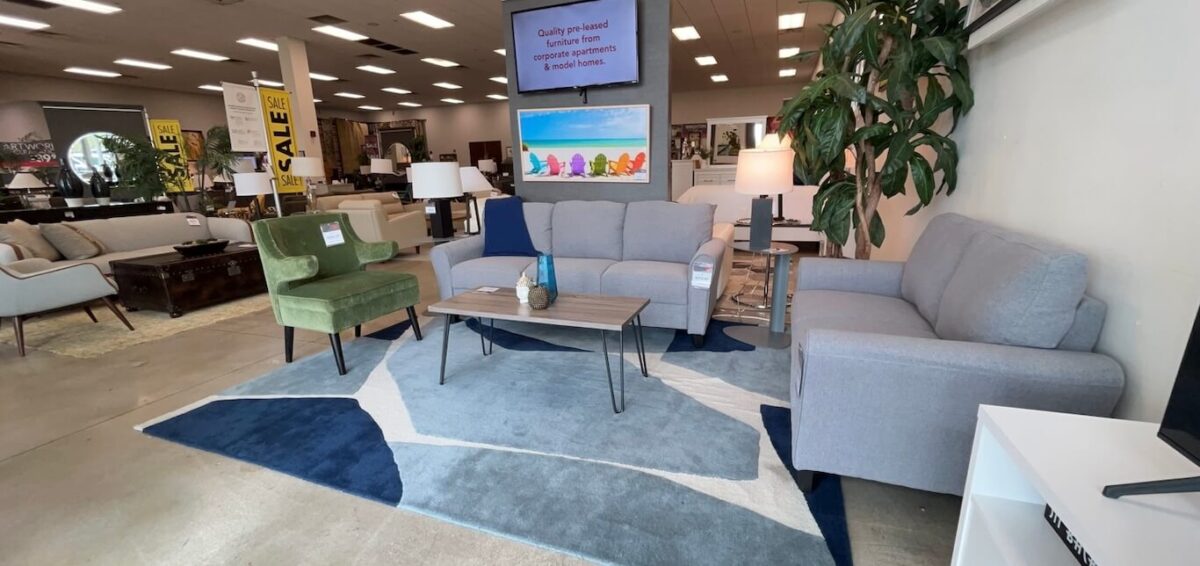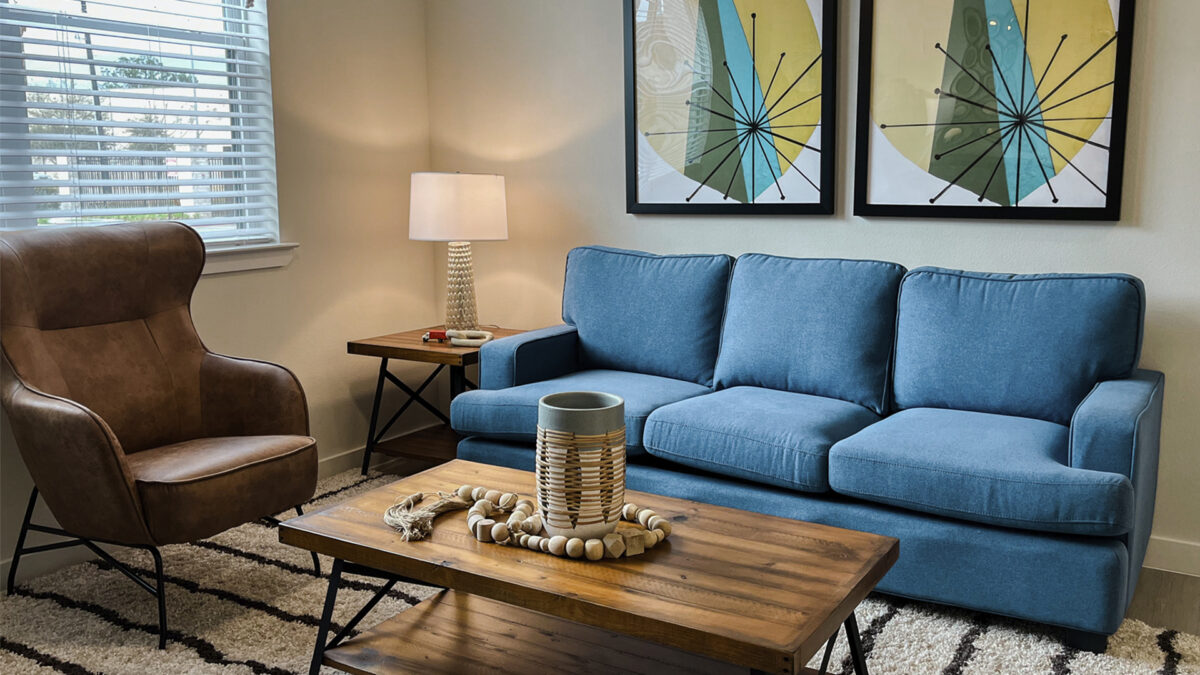One of the first things people think about when they begin to decorate their new house, condo, or apartment is the living room. It’s the most prominent area in the home — if you have friends or family over to visit, it’s likely the gathering spot. It’s movie night when you have a date over or have a date night with your spouse. Anyone that enters your home sees the living room, so it’s an area you want to highlight.
However, that desire to want to make it perfect can often turn to frustration. Does this rug go with these drapes? Is there too much furniture in the room?
There are considerations to make when you’re furnishing a studio apartment compared to a larger apartment because you have so much less space to work with, but many of the ideas are the same. Read on to learn some tips and tricks when it comes to decorating your living room.
Area Rug Placement
Unless you have wall-to-wall carpeting, you likely have hardwood flooring you’d like to place an area rug on. This is tricky, especially if you live in a studio or smaller space because a large rug can overwhelm the room. However, this doesn’t mean you can’t have a rug, of course — it just means you have to follow a few simple tips for aesthetics.
Rugs Go Down First
It may sound like common sense, but rugs must go down before your furniture. This is because your furniture should be on top of the rug to pull in the look of the room. It doesn’t need to completely cover the rug, but your primary furniture should be all touching the rug slightly. Also, when shopping for a rug, take photos of your furniture (and decor) with you to make sure everything matches up. You may love a rug, but it may not match your furniture.
Rug Size Matters
A rug that is too small can give the entire room a disjointed look. This is why ideally the rule of thumb is your furniture should be touching it. It’s a good way to ensure that the size of the rug fits your room, whether you have a small or large living room. Also, you should have about 10 to 20 inches of bare floor between the rug and the edge of the room.
Using Multiple Rugs in Small Spaces
If you do have a small space, there’s no hard-and-fast rule that you must use a large area rug. You can mix and match different rugs on your floor as you need them; for example, by the coffee table or in another centrally located part of the room. When it comes to small rugs, however, always make sure to buy slip pads, as they can be a safety hazard.
Furniture and Traffic Flow
If you’re someone that has friends and family over often, one of the main considerations when it comes to your living room design is traffic flow and how you set up your furniture. If you entertain, you especially want to think about how guests will mill about.
One of the most common faux pas in decorating a living room is pushing all of your furniture against a wall. While it may be comfortable and may seem to work if you’re trying to create a look, this likely isn’t the one you want unless it’s a last resort, mainly because it works against is ignoring traffic flow.
So, whether you’re rearranging your living room or are just moving in, think about traffic patterns and how they may flow best. Oftentimes, having the sofa pushed right against the wall isn’t the best option.
Find the Focal Point
Once your rug is placed, find the focal point of the room. If you’re working with a larger space, this can actually be more challenging than if you have a smaller space. This should be the spot your eyes are automatically drawn to when you enter. It could be the fireplace or an architectural feature that stands out. From here is where you may want to design your furniture pieces. If you have rental furniture, such as with CORT, there are design professionals that can help you with these types of interior design tasks.
Having Conversation Areas
You also want to ensure that people are able to easily talk to one another — no one wants to shout across the room. This is part of why furniture placement is so important. If you have chairs, they should likely face the sofa or loveseat in a way that makes sense. Similarly, your sofa and loveseat shouldn’t be side by side but should be placed in a way so that they can “talk” to each other.
Not Overdoing Furniture
It can be incredibly easy to fall into the trap of having too much furniture and decor. If you’re just moving in, decluttering before moving is a great way to minimize this problem. If you’re in a studio or smaller space, it can sometimes be hard to overcome. Ideas such as nesting tables, ladder storage, and shelving, and storage ottomans are great ideas to break down clutter while still having a living room that looks wonderful. When guests come over, simply pop the nesting tables out.
Choosing Paint
Many people decide to paint over what’s already there in order to match their furniture, decor, or the mood they wish to create in their living room. Also, wallpaper is trending and can make a bold statement.
Rules of Thumb With Paint
If you decide to repaint, understand the rules of light and dark paint. If you paint a room lighter, it will make the room look bigger. If you paint a room darker, it will make the room look smaller. It all depends on what you are trying to achieve with repainting. If you’re simply trying to match your furniture and decor, just bear these rules in mind as you paint. The same rules apply to wallpaper as well.
Wallpaper as a Trend
When you think of wallpaper, it may bring up memories of grandma’s house, but the wallpaper trend has been on the upswing for some time. On the difficulty scale, wallpaper isn’t as hard as it sounds, and it can make a bold statement in your living room. You can always bring a patch home to match your furniture and decor. One thing to keep in mind with wallpaper, however — you want to make sure it matches your wall art.
Painting Before Moving In
It’s a good idea to paint (or wallpaper) before moving in if it can be helped. If you’re redecorating, obviously there’s no choice in the matter. However, if you’re all moved in and then decide to repaint or wallpaper your living room it’s tough to move all that furniture around. So it’s a good idea to match, measure and paint well before the furniture arrives.
Using Lighting Correctly
Dim or too bright lighting can make a living room feel like a cave or make it too brassy. However, there’s a perfect way to capture the right amount of light, whether you have a small or large space, and whether you have a lot of natural light coming in or not. In fact, you should have several types of lighting in your living room to keep it “just right” — not too bright, not too dim.
Lighting Placement
The living room isn’t a utilitarian room like your kitchen, so placement isn’t as obvious (such as over the stove, over the sink, etc.). Consider an overhead light, a table light, and a floor lamp for balance and different lighting options throughout the day and evening. For more light, you can also opt for wall sconces and recessed lighting. You want these at different points in the room so not just one area is too brightly lit or too dim.
What Types of Lighting
The type of lighting you use matters as well. You should mix and match three types of lighting: ambient light, task light, and accent light. You may have to play around a bit as to which type of light goes where until you get the best feel for the room, but ideally you should be using all three in order to get the proper aesthetic.
If you’re looking for a perfectly designed living room with furniture that helps bring your vision to life, CORT Furniture Rental can help. The CORT process is designed to be as easy and painless for you as possible. We will handle as much or as little as you want, always with our CORT Commitment™ in mind.






